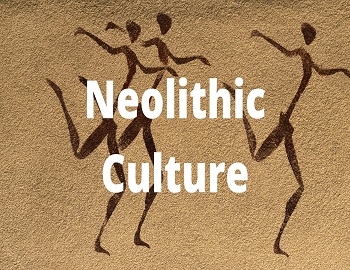Table of Contents
What is Neolithic Culture?
The term Neolithic or New Stone Age is derived from two Greek words, neo meaning ‘new’ and lithos meaning ‘stone’. It is generally defined as a way of life involving crop cultivation, animal husbandry and settled life. It roughly extended from about 9000 BC to 3000 BC. In India, the Neolithic Age began from about 7000 BC and lasted till 1800 BC.
This period saw the invention of pottery, weaving, permanent house construction, growing complexity in social structure, specialization and division of labour etc.
Important Tools of Neolithic Culture:
The characteristic tool of this period is polished and ground tools collectively called celts. There were made on Dolerite or sandstone. The common tool types are axe, adze, chisel, wedges, hoe, ringstone or mace heads. The bone and antlers also were used to make harpoons, arrowheads, scrapers, needles with eyes and points.
In India, the Neolithic and Chalcolithic are difficult to separate, mainly because of the lack of stratigraphic bases. By definition, in a pure Neolithic culture metal was unknown. Use of copper begins with chalcolithic. Another problem is the contemporary of Neolithic on the one hand and Indus Valley Civilization on the other. On a purely technological basis, a Neolithic is characterized by the presence of-
- Celts.
- Pit-dwelling.
- Pottery.
Whenever or where ever either or all of these occur at any site it is taken to be Neolithic. Pit-dwelling as the term denotes was the first relatively permanent residential pattern where people used natural pits to live. They lived on the floor and covered the mouth of the pits with thatched covering resting on post-holes. The potsherds show a gradual evolution from hand-made unfired variety to wheel-made and fired one.
Zones of Neolithic India:
Neolithic India has been divided into three zones-
- Northern Neolithic.
- Eastern Neolithic.
- Southern Neolithic.
Northern Neolithic:
The most important Neolithic site in North India is Burzahom. This, along with Gufkral and Martand gives us a fairly good idea of the Neolithic life, situated in Jhelum Valley near Srinagar. The sites have been dated to around 2375 BC by Radio-Carbon Method. It appears that people in Kashmir were still in the Neolithic stage when the Harappa civilization was at its peak in the South-West.
Dwellings- Pit dwelling is the most distinctive characteristic of the period. A large pit had a mouth of 2.7 meters diameter expanding to 4.6 metres at the base with a depth of about 4 metres. People lived and cooked on the floors of these pits. Steps were cut along one wall to facilitate entry. The presence of the kitchen within the pit is shown by ash and charcoal. The kitchen was also the cause of the burning of the roof. Forty-five post-holes were found around one of the pits, suggesting repeated repairs.
Tools and Pottery- The characteristic feature of the Neolithic are the ground and polished tools. The tools collected from the site are axes, adzes, chisels, hoe, pick, mace-heads etc. The main pots were a bowl, vase and stem. These were hand-made, with a coarse surface. A 26″ tall vessel is the best example of their craft.
Burial- They buried their dead in pits that were generally oval or circular in shape. The pits were wide at the base and narrow at the top. Their most important pets dog and ibex were buried with them.
Eastern Neolithic:
Assam and adjoining states provide the site of Neolithic. The most important site is Deojali-Hading in the North Cachar Hills of Assam. This small excavation has given for the first time stratigraphical occurrence of ground or polished stone axes and also pottery in a fairly deep deposit. The ground and polished celts are mostly shouldered at the butt end and had a ground sharp border.
At the confluence of river Ghaghra and Ganga near Chhapra in Bihar, a fairly well developed Neolithic site has been excavated. Unlike Deojali Hading and Burzahom, Chirand is not a hill but lies in alluvial plains. It is the only site to have yielded so many varied types of bone tools i.e. celts, scrapers, hammers, chisels, borers, needles, points, awls, shaft straighteners and arrowheads. Bone was also used to make ornaments such as pendants, bangles, earrings, discs and comes. The Neolithic inhabitants of Chirand lived in circular huts of about 2 metres in diameter, set close to one another. The walls were made of bamboo screens plastered over with mud on both sides. The floors were paved and the roofs were probably conical and thatched. The pots and pans show a great regularity of form and fine surface finish. Pots with a wide or narrow mouth, bowls with stand, lipped bowls etc. are the main types. The pots are decorated with post-firing other paint, and applique designs.
Koldihwa situated near Allahabad, this site becomes famous because it yielded, the oldest remains of the rice. Ground stone axes and microlithic blades are found here. They also lived in circular huts, but these are marked by post-holes. Cattle pen with hoo-impression on the floor is also found, suggesting domestication of animals. The pot-sherds suggest that pots were crude, hand-made and ill fired.
Southern Neolithic:
As in earlier cultural stages, Andhra Pradesh and Karnataka are also the most important as far as Neolithic sites are concerned. Tekkalkota, Brahmagiri, Sangankallu and Hallur in Karnatka; Piklihal and Nagarjunkonda in Andhra Pradesh and Paiyapalli in Tamil Nadu are the best known sites.
Tekkalkota- situated in the Bellary district of Karnataka the site is a granite hill and dated about 1600 BC by the radiocarbon method.
Dwelling- Nineteen huts were found at this site. These show variations in structure. Although all of them are circular in shape, some are free-standing with walls of wattle and daub, while others are supported by a natural circle of boulders. The diameter of the huts is about 3 to 5 metres. The floor was paved and coated with lime.
Burial- Mostly the dead were buried beneath the floor of the huts. Burial within an urn was also found. Funerary vessels are also found at the feet of skeletons.
Pottery- The pottery is predominantly hand-made, but well fired and coloured. Grey, Brown and Buff colours are common. Pots with spouts- as in tea kettle were also made. They were usually decorated by painting after firing, incision, rustication and perforation.
Tool- Axes, adzes, pointed tools, chisels, querns, mace-head or ring-stones are the major tool types. The axes were varied in length and thickness, thus of many subtypes.
Neolithic Culture:
A survey of Neolithic sites in India shows that whole of India was inhabited by people during this age. The dwelling structures whether pit dwelling or overground huts make it clear that nomadic life had ended and people had started living at one place on a permanent basis. The toolkit bears testimony to the fact that cutting of trees and clearing of forest for cultivation had begun. The querns were used for grinding the grains. The pots were used for storing the grains, the greater leisure resulted in people taking to art forms.
We may conclude that this was the beginning of life-based on cultivation that was later to develop into larger agricultural communities when first copper and then bronze became a part of the culture.









Comments (No)